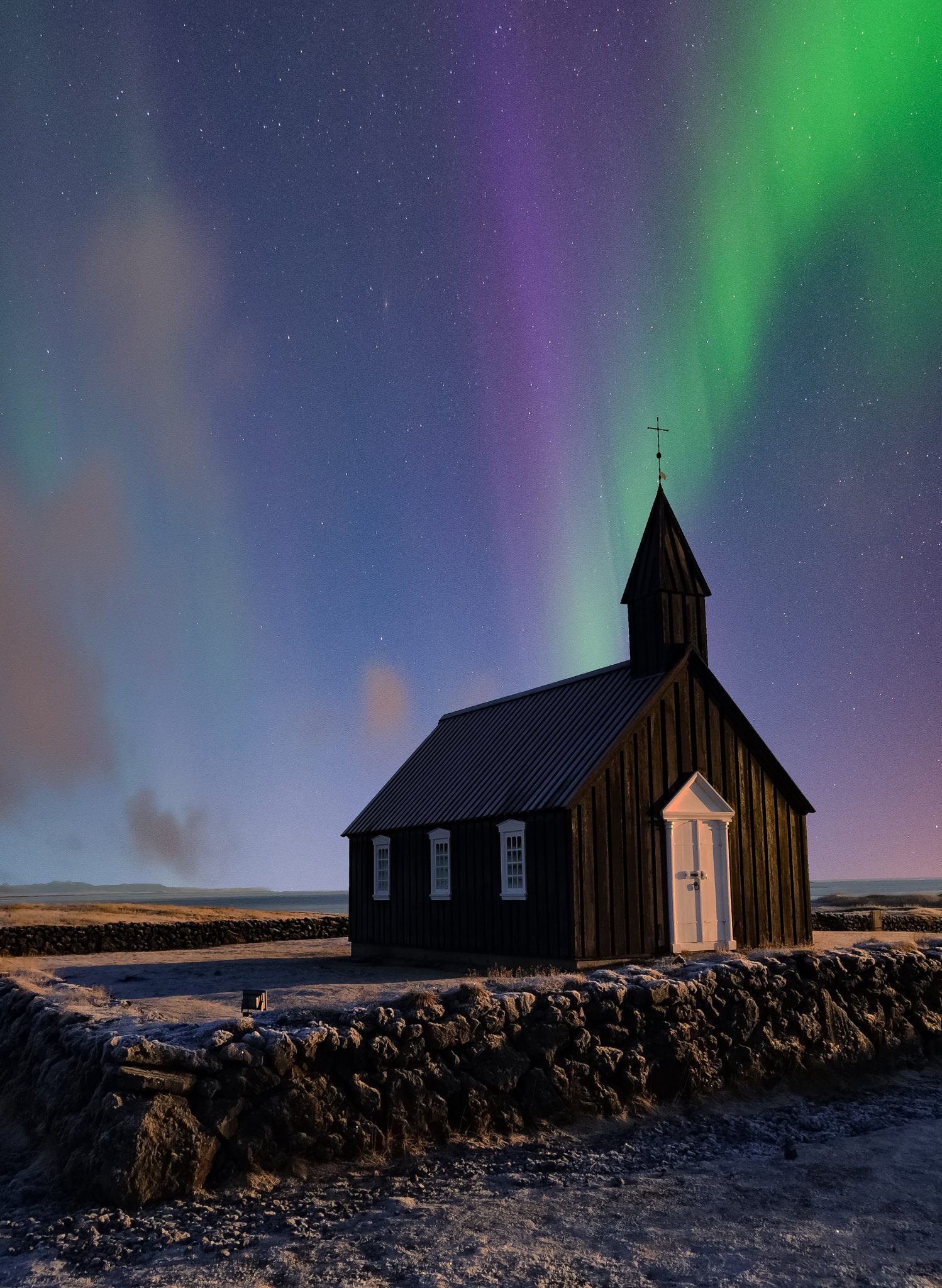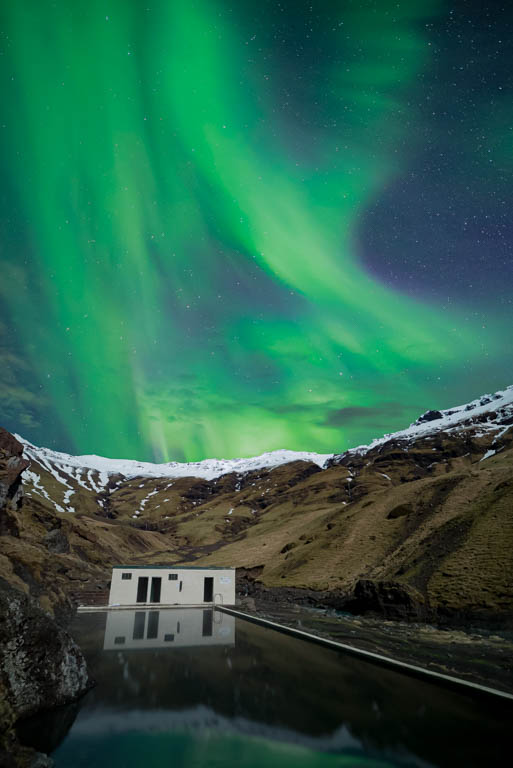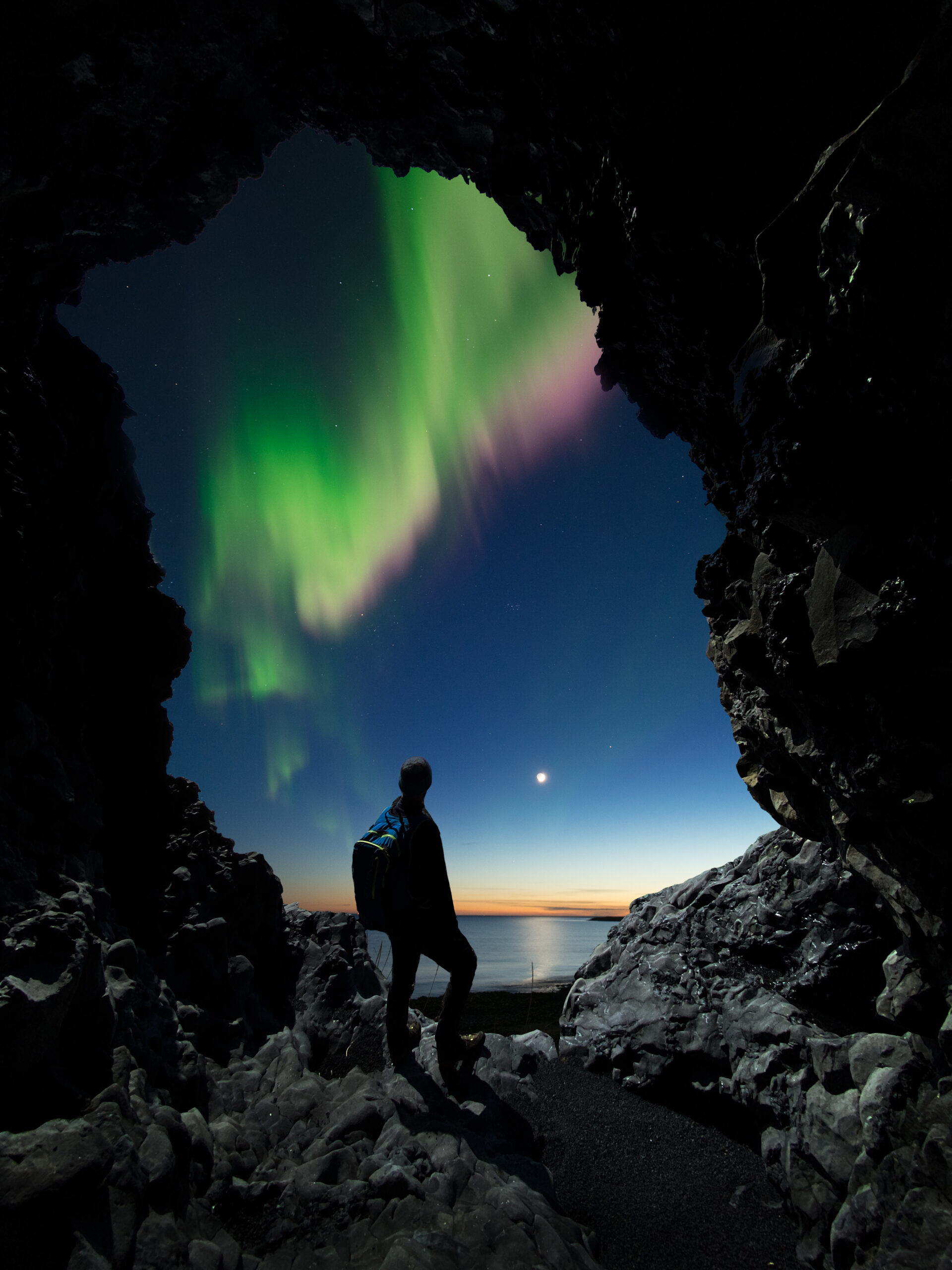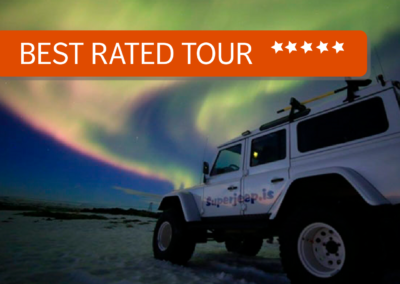THE ULTIMATE GUIDE TO SEEING THE NORTHERN LIGHTS IN ICELAND
Best time
Best places
Best tours
There is perhaps nothing more magical than witnessing the beauty of a Northern Lights display, and it has been a lifelong dream of many. However, those unpredictable, ever dancing lights don’t always show up on cue.
Here is all you need to know to make your aurora dream come true!

Northern Lights at Straumur, an old farm close to Reykjavík
Witnessing the Northern Lights in Iceland requires knowledge, patience and a little bit of luck. For catching a beautiful display, you will need a few factors in your favor:
- darkness,
- clear skies (or openings in the cloud cover),
- good solar activity (usually the case over Iceland),
- little to no light pollution.
Darkness
To see the Northern Lights, darkness is required – making the hunt for the lights a night-time activity. From the end of August to mid-April, the skies are dark enough to witness auroral displays in Iceland.
Clear skies
The Northern Lights occur above our weather system; therefore, clouds can spoil the visibility. The Northern Lights forecast offers a regularly updated prediction for total cloud cover over the country. As weather and wind direction change fast in Iceland, conditions are almost unpredictable at times, and tour operators often decide in the late afternoon whether factors are favorable enough to head out for the night hunt. If you go on your own, check where chances for clear skies are best right before you start your Aurora adventure.
Solar activity
The strength of an auroral display depends on the solar activity, which is measured with the so-called KP index, ranging from 0 to 9. The higher the number on the scale, the higher the auroral activity and the better your chances of witnessing fast dancing lights in various colors. However, the Sun is constantly emitting solar particles, and even a low or moderate KP (2 or 3) is usually enough to experience good Northern Lights over Iceland.
Keep in mind that the index offers a forecast, but no guarantee that the Northern Lights will occur at any given time.
We have witnessed nights with a predicted KP7 and absolutely no lights, and even more often nights with a predicted KP 2 and lights dancing across the sky. If skies are clear, head out – no matter the KP.
You can monitor the KP index here.
Light pollution
The further away you get from any source of light pollution, the better your chances of seeing the Aurora Borealis are. Leave the city behind and immerse yourself in the vast and rugged Icelandic nature – that’s where the real adventure starts!
Pro-tip: Keep in mind that the Moon creates light pollution too. If you are hoping to experience the Northern Lights at their best, we highly recommend choosing a period with little to no Moon.
The most common auroral color is green, but colors can vary from white, green, pink and purple, depending on the elements being ionized.
The Northern Lights appear in the polar regions, in the so-called auroral oval.
Located straight in the middle of this oval, Iceland is the perfect destination for observing the Northern Lights.

Northern Lights at Búðir
When is the best time to see the Northern Lights?
In Iceland, the Aurora season starts in late August and ends around mid-April. Any time during this period is favorable and has its advantages.
Statistically, the Aurora is most often seen around the equinoxes in September/October and March/April.
As Northern Light photographers, we personally love September/October – here is why.
How to see the Northern Lights in Iceland
You have several options to see the Northern Lights in Iceland:
- Hunting the lights in Reykjavík,
- Joining a guided tour,
- Renting a car and going on your own hunt,
- Taking a Northern Lights evening cruise.

Northern Lights at Skógafoss
Hunting the Northern Lights in Reykjavik
“Can you see the Aurora from the city?” is a frequent question of hopeful Aurora hunters. The answer: yes, you can – if conditions are favorable.
However, the experience will not be as rewarding as it can be when you leave the city lights behind and head out into the arctic wilderness. We often compare it to watching a movie at the cinema with all the lights switched on. Dust and electrical illumination make it hard to see the auroral lights, so your eyes will process them rather faint and not as colorful.
That being said, if budget is a concern, you can always try to catch the Aurora from around town.
Find here the best spots to see the Northern Lights in Reykjavík.

Northern Lights above Aurora Reykjavík
Joining a guided Northern Lights Tour
The most common way to hunt for the Aurora Borealis is to take a guided tour. Several tour operators run excursions regularly from September to April, offering a wide range of different tours for all kind of budgets and personal preferences:
- bus and minibus tours,
- super jeep tours,
- photo tours,
- private tours,
- and a variety of combo-tours that are worth considering.
As unpredictable as the Aurora can be, tour operators try their best to catch the Northern Lights for you and make it a truly unique experience. If your tour gets canceled due to unfavorable weather conditions or no lights are seen, you will get the opportunity to reschedule or retry at no additional charge.
Joining a guided tour is often a fitting choice for a number of reasons:
- You will be under the guidance of an expert who knows where to find the lights and how to photograph them,
- You will be able to easily reach areas where the forecast is the most promising,
- You will be traveling with like-minded people,
- You won’t need to worry about driving in Iceland’s harsh winter conditions.
Those on a budget will appreciate reasonably cheap bus tours, which will take you on a hunt without breaking the bank.
Minibus tours offer a small group experience, and often include valuable extras such as hot drinks on board or photos of you under the Northern Lights taken by your expert guide. These excursions are operated on smaller vehicles than regular bus tours, allowing more flexibility when searching for the right spot to see the Aurora.
If you want to make your Northern Lights hunt a real once-in-a-lifetime experience, we highly recommend choosing a super jeep tour. These excursions surely offer the most personal, immersive experience and the highest chances of witnessing a spectacular display – often off the beaten path.
You can find our favorite tours here.

Photo from our popular Northern Lights Superjeep tour
Joining a Northern Lights Evening Cruise
Another way to have an unforgettable Northern Lights experience is to join an Aurora evening cruise. Aurora cruises are designed for comfort, with heated indoor areas featuring a bar and toilet facilities, and warm overalls at disposal for Northern Lights watching on the decks.
Keep in mind that boats do not allow the same degree of mobility as bus or jeep tours can offer, and, due to the movement of the boat, photographing the Northern Lights with long exposure settings may result tricky.
The main strength of a Northern Lights cruise is not so much the ‘hunt’ for the lights itself, as the out-at-sea experience, the enchanting landscapes and stunning views of the Reykjavík or Akureyri skyline under the Aurora.

Photo from Reykjavik Northern Lights Cruise

Northern Lights at Kirkjufell
How are my chances to see the lights – and how can I enhance them?
The Sun is constantly emitting plasma, and chances to see the Northern Lights are usually quite good, keeping a few points in mind:
1. Consider a guided tour with an experienced guide
Northern Lights hunting can be tricky, and we highly recommend relying on the knowledge and experience of a local tour guide. People often fail to see the lights for very simple reasons – i.e. being on the wrong side of a mountain range, while the lights are happily dancing hidden behind the peaks.
2. Plan the length of your stay in Iceland wisely
The Northern Lights tend to be very active for 2-3 nights, then quiet for 4-5 nights, in ongoing cycles. The longer your stay the higher your chances.
3. Book your tour for the first night of your stay
In case your tour gets canceled on the first night at your disposal due to unfavorable weather conditions or no lights are seen, you will still have time to reschedule or make use of your free retry. And, even if you are lucky and catch them on your first tour, you might want to try again on your own the following nights!
4. Patience is the key
The Northern Lights tend to occur around magnetic midnight, which converts to 11pm Icelandic time. However, they can occur at any time – darkness required. Dress up properly, grab a thermos of hot chocolate and a blanket, and head out for a long night under the arctic sky!
Best places to see the Northern Lights in Iceland
Chances to see the Northern Lights are about the same all over Iceland, due to its ideal location under the auroral oval.
It is all a matter of clear and dark skies, so any place away from light pollution and clouds is potentially fine at these latitudes.
However, here are our personal recommendations:

Northern Lights at Seljavallalaug
- Being next to an unfrozen lake, like Þingvellir, gives the opportunity to witness amazing reflections,
- The Blue Lagoon is not only a perfect spot to take a relaxing swim, but also to observe some beautiful auroral displays,
- The countless waterfalls on the south shore of Iceland, like Skógafoss, make a perfect scenic foreground for stunning Northern lights shots.

Northern Lights at Akureyri
What to bring for a Northern Lights adventure
Here are some essentials to make your Northern Lights hunt a great experience:
- Warm, wind- and waterproof clothes – dress preferably in layers,
- Warm and steady shoes,
- Thermos bottle with hot drinks,
- Snacks,
- Hand- and toe warmers,
- Headlamp, ideally with red light.
For photographing, you will need:
- Camera or phone with manual mode settings,
- Tripod,
- Spare batteries

Lakes and ponds create beautiful reflections
How to Photograph the Northern Lights
- Use a Tripod: A stable camera is essential for long exposures.
- Wide-Angle Lens: Capture as much of the sky as possible.
- Manual Settings: Start with an aperture of f/2.8, ISO 1600, and a shutter speed of 10-15 seconds. Adjust as needed.
- Foreground Interest: Include mountains, waterfalls, or trees to create compelling compositions.
For a detailed photography guide, read our Northern Lights Photography Tips.

Northern Lights at Skógafoss
Hunting for the Northern Lights is always an adventure, and witnessing a display of this magical phenomenon will last in your memory for a lifetime.
Tell us about your experiences in the comments!
Join us on a guided Northern Lights Tour
FAQs About the Northern Lights
1. Can I see the Northern Lights in summer?
No, the midnight sun in summer makes the sky too bright for aurora visibility. Plan your trip for winter months.
2. What colors can I expect to see?
Green is the most common color, but under strong solar activity, you may see pink, red, and purple.
3. Are the Northern Lights guaranteed?
While auroras occur every night, visibility depends on weather and solar activity. Many tours offer a retry guarantee if you don’t see them.
External Resources
Enhance your aurora knowledge with these trusted resources:
- NOAA Aurora Forecast – Real-time updates on geomagnetic activity.
- Space.com Northern Lights Guide – Learn about the science behind the aurora borealis.
- Visit Iceland Official Site – Plan your trip to Iceland with ease.
By following this guide, you’ll be well-prepared to experience one of nature’s most magical displays. Whether you’re planning your trip or already in Iceland, the aurora awaits!






